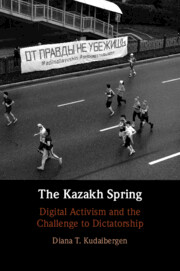Book contents
- The Kazakh Spring
- The Kazakh Spring
- Copyright page
- Dedication
- Contents
- Figures
- Tables
- Acknowledgements
- Introduction
- 1 What Is the Kazakh Spring?
- 2 Who Are Oyan, Qazaqstan?
- 3 Deconstructing Vlastʼ
- 4 Performing the State, Performing the Protest
- 5 Generation Q and Decolonizing Alash
- 6 The Public Square and the Body under Authoritarian Pressures
- 7 Queering the Public Sphere
- 8 Making Sense of the Bloody January 2022 Mass Protests
- Conclusions
- References
- Index
1 - What Is the Kazakh Spring?
Published online by Cambridge University Press: 16 May 2024
- The Kazakh Spring
- The Kazakh Spring
- Copyright page
- Dedication
- Contents
- Figures
- Tables
- Acknowledgements
- Introduction
- 1 What Is the Kazakh Spring?
- 2 Who Are Oyan, Qazaqstan?
- 3 Deconstructing Vlastʼ
- 4 Performing the State, Performing the Protest
- 5 Generation Q and Decolonizing Alash
- 6 The Public Square and the Body under Authoritarian Pressures
- 7 Queering the Public Sphere
- 8 Making Sense of the Bloody January 2022 Mass Protests
- Conclusions
- References
- Index
Summary
In this chapter, I contextualize the authoritarian systematization of the political field that made it so inaccessible to non-regime elites and newcomers. I argue that this context negatively influenced the established opposition and the regime elites on the eve of Nazarbayev’s resignation. None of them were ready to react to such drastic changes in the political field. As a result, the established opposition disintegrated following a number of scandals, and the remaining opposition politicians had to move to populist calls to sustain their potential electorate. Within Nazarbayev’s regime, the elites remained stagnant and disoriented; they focused too much on what was happening within the regime itself and did not manage to meet the growing societal discontent and protests. These conditions left newly elected president Tokayev in an uneasy situation where, on the one hand, he had to deal with continual crises; on the other hand, this type of intra-elite concentration within the regime offered a unique opportunity for new, unknown political forces to emerge in the public sphere. This is how the Kazakh Spring was born as an alternative political field of opportunities.
- Type
- Chapter
- Information
- The Kazakh SpringDigital Activism and the Challenge to Dictatorship, pp. 35 - 59Publisher: Cambridge University PressPrint publication year: 2024

